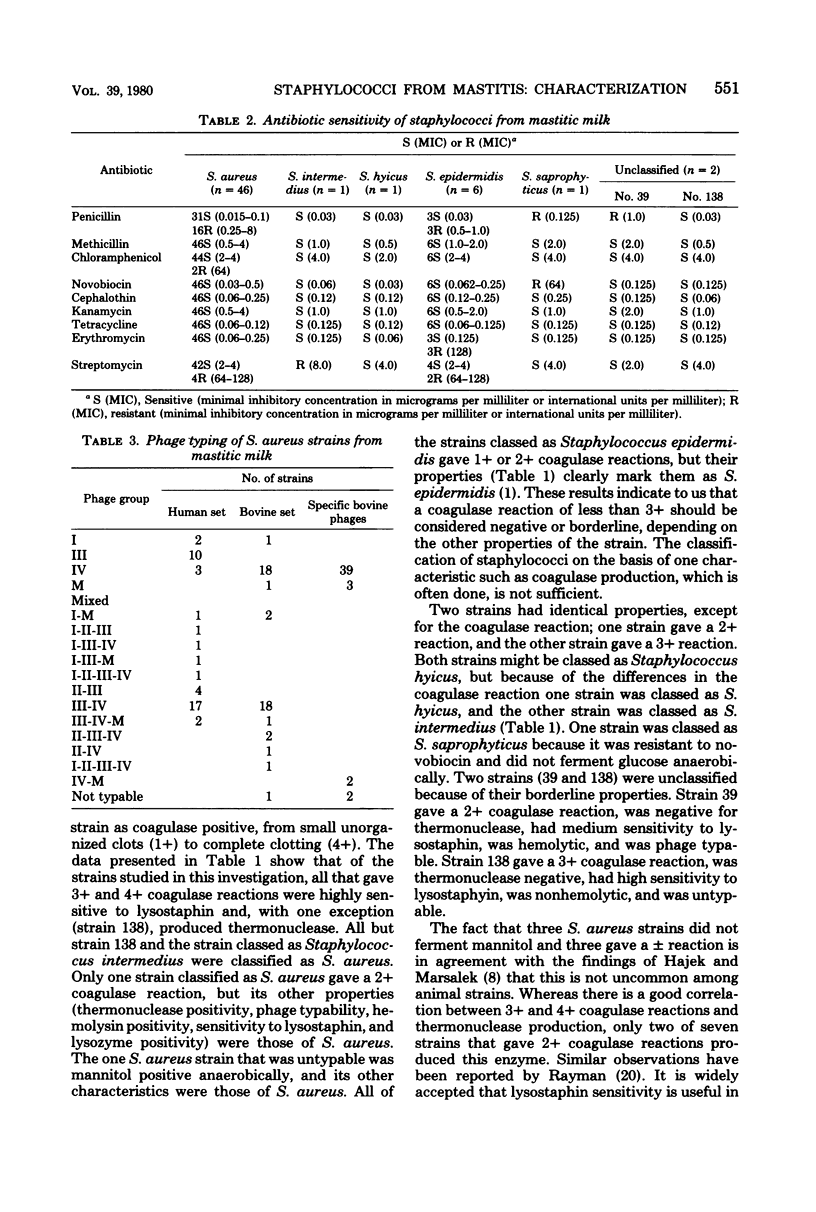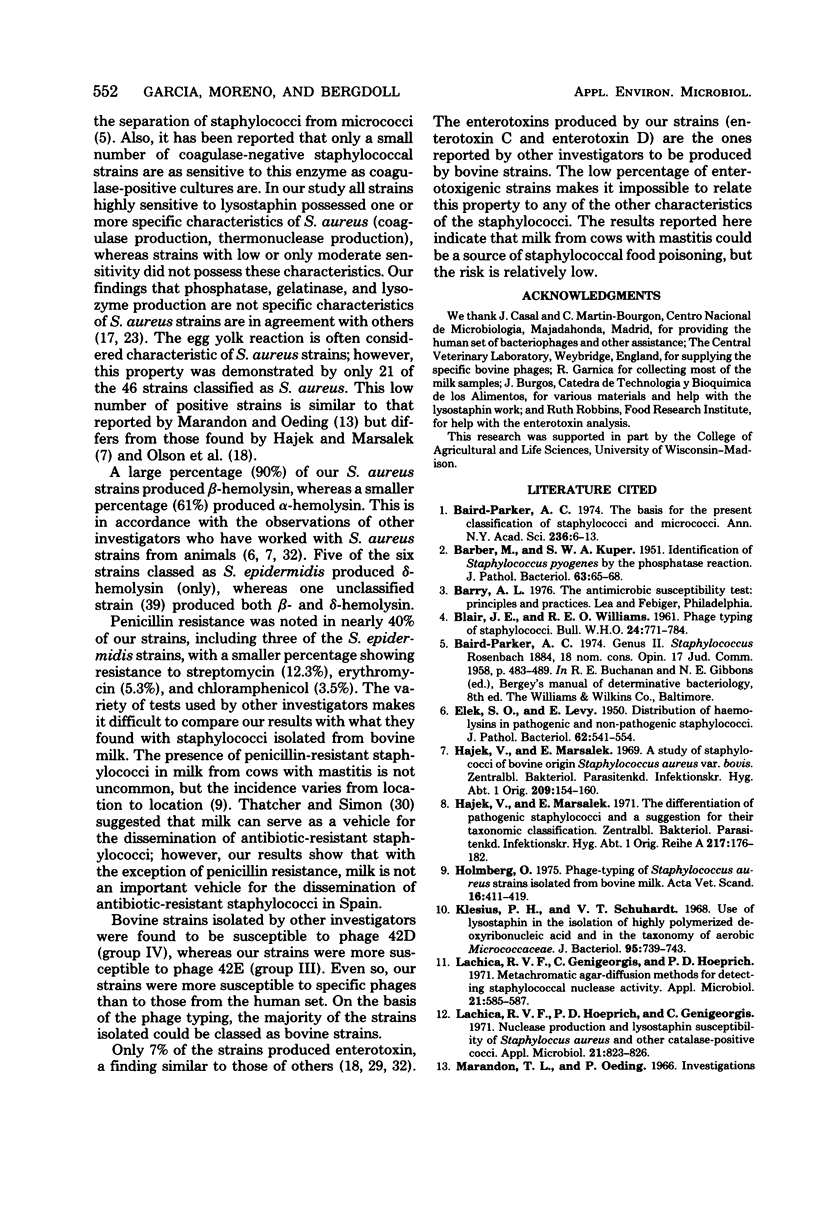Abstract
A total of 57 gram-positive, catalase-positive cocci, considered etiological agents of clinical and subclinical bovine mastitis, were tested for glucose and mannitol fermentation, coagulase and thermonuclease production, sensitivity to lysostaphin, gelatin hydrolysis, lysozyme, phosphatase and egg yolk factor production, hemolytic properties, antibiotic sensitivity, susceptibility to human and bovine phages, and enterotoxin production. All 57 strains were identified as staphylococci. A good correlation was found between 3+ and 4+ coagulase reactions, thermonuclease production, and high sensitivity to lysostaphin. Neither mannitol fermentation nor production of other enzymes appeared to be a specific property of bovine Staphylococcus aureus strains. beta- and delta-hemolysins were more frequently found than alpha-hemolysin. Nearly 40% of the strains were penicillin resistant. Strains were lysed by phage 42E from the human phage set more frequently than by phage 42D, whereas with the bovine set, strains were more sensitive to specific bovine phages. Three strains produced enterotoxin C, and one strain produced enterotoxin D.
Full text
PDF





Selected References
These references are in PubMed. This may not be the complete list of references from this article.
- BARBER M., KUPER S. W. A. Identification of Staphylococcus pyogenes by the phosphatase reaction. J Pathol Bacteriol. 1951 Jan;63(1):65–68. doi: 10.1002/path.1700630108. [DOI] [PubMed] [Google Scholar]
- ELEK S. D., LEVY E. Distribution of haemolysins in pathogenic and non-pathogenic staphylococci. J Pathol Bacteriol. 1950 Oct;62(4):541–554. doi: 10.1002/path.1700620405. [DOI] [PubMed] [Google Scholar]
- Holmberg O. Phage typing of Staphylococcus aureus strains isolated in Sweden from bovine milk. Acta Vet Scand. 1975;16(3):411–419. doi: 10.1186/BF03546659. [DOI] [PMC free article] [PubMed] [Google Scholar]
- Hájek V., Marsálek E. A study of staphylococci of bovine origin Staphylococcus aureus var. bovis. Zentralbl Bakteriol Orig. 1969 Jan;209(2):154–160. [PubMed] [Google Scholar]
- Hájek V., Marsálek E. Differenzierueng pathogener Staphylokokken und Vorschlag für ihre taxonomische Klassifikation. Zentralbl Bakteriol Orig A. 1971 Jun;217(2):176–182. [PubMed] [Google Scholar]
- Klesius P. H., Schuhardt V. T. Use of lysostaphin in the isolation of highly polymerized deoxyribonucleic acid and in the taxonomy of aerobic Micrococcaceae. J Bacteriol. 1968 Mar;95(3):739–743. doi: 10.1128/jb.95.3.739-743.1968. [DOI] [PMC free article] [PubMed] [Google Scholar]
- Lachica R. V., Genigeorgis C., Hoeprich P. D. Metachromatic agar-diffusion methods for detecting staphylococcal nuclease activity. Appl Microbiol. 1971 Apr;21(4):585–587. doi: 10.1128/am.21.4.585-587.1971. [DOI] [PMC free article] [PubMed] [Google Scholar]
- Lachica R. V., Hoeprich P. D., Genigeorgis C. Nuclease production and lysostaphin susceptibility of Staphylococcus aureus and other catalase-positive cocci. Appl Microbiol. 1971 May;21(5):823–826. doi: 10.1128/am.21.5.823-826.1971. [DOI] [PMC free article] [PubMed] [Google Scholar]
- Marandon J. L., Oeding P. Investigations on animal Staphylococcus aureus strains. 1. Biochemical characteristics and phage typing. Acta Pathol Microbiol Scand. 1966;67(1):149–156. doi: 10.1111/apm.1966.67.1.149. [DOI] [PubMed] [Google Scholar]
- Olson J. C., Jr, Casman E. P., Baer E. F., Stone J. E. Enterotoxigenicity of Staphylococcus aureus cultures isolated from acute cases of bovine mastitis. Appl Microbiol. 1970 Oct;20(4):605–607. doi: 10.1128/am.20.4.605-607.1970. [DOI] [PMC free article] [PubMed] [Google Scholar]
- Robbins R., Gould S., Bergdoll M. Detecting the enterotoxigenicity of Staphylococcus aureus strains. Appl Microbiol. 1974 Dec;28(6):946–950. doi: 10.1128/am.28.6.946-950.1974. [DOI] [PMC free article] [PubMed] [Google Scholar]
- Roskey C. T., Hamdy M. K. Bruised poultry tissue as a possible source of staphylococcal infection. Appl Microbiol. 1972 Apr;23(4):683–687. doi: 10.1128/am.23.4.683-687.1972. [DOI] [PMC free article] [PubMed] [Google Scholar]
- ST GEORGE C., RUSSELL K. E., WILSON J. B. Characteristics of staphylococci from bovine milk. J Infect Dis. 1962 Jan-Feb;110:75–79. doi: 10.1093/infdis/110.1.75. [DOI] [PubMed] [Google Scholar]
- Schleifer K. H., Kloos W. E. A simple test system for the separation of staphylococci from micrococci. J Clin Microbiol. 1975 Mar;1(3):337–338. doi: 10.1128/jcm.1.3.337-338.1975. [DOI] [PMC free article] [PubMed] [Google Scholar]
- Sperber W. H., Tatini S. R. Interpretation of the tube coagulase test for identification of Staphylococcus aureus. Appl Microbiol. 1975 Apr;29(4):502–505. doi: 10.1128/am.29.4.502-505.1975. [DOI] [PMC free article] [PubMed] [Google Scholar]
- THATCHER F. S., SIMON W. The resistance of staphylococci and streptococci isolated from cheese to various antibiotics. Can J Public Health. 1955 Oct;46(10):407–409. [PubMed] [Google Scholar]
- TURNER F. J., SCHWARTZ B. S. The use of a lyophilized human plasma standardized for blood coagulation factors in the coagulase and fibrinolytic tests. J Lab Clin Med. 1958 Dec;52(6):888–894. [PubMed] [Google Scholar]
- Terplan G., Zaadhof K. J. Zur diagnostischen und lebensmittelhygienischen Bedeutung von Staphylococcus aureus in Kuhmilch. Dtsch Tierarztl Wochenschr. 1969 May 11;76(9):217–221. [PubMed] [Google Scholar]
- WALLACE G. D., QUISENBERRY W. B., TANIMOTO R. H., LYND F. T. Bacteriophage type 80/81 staphylococcal infection in human beings associated with mastitis in dairy cattle. Am J Public Health Nations Health. 1962 Aug;52:1309–1317. doi: 10.2105/ajph.52.8.1309. [DOI] [PMC free article] [PubMed] [Google Scholar]


